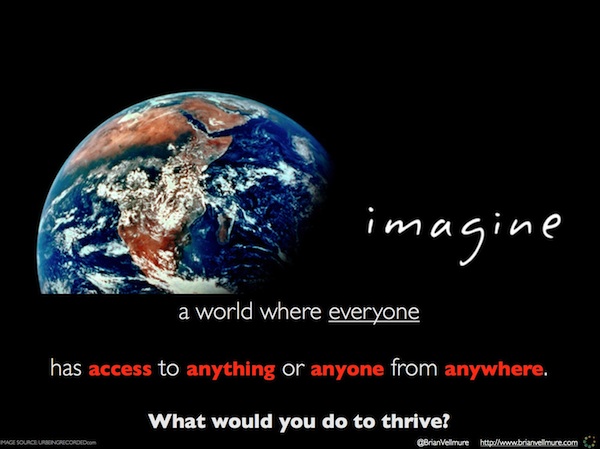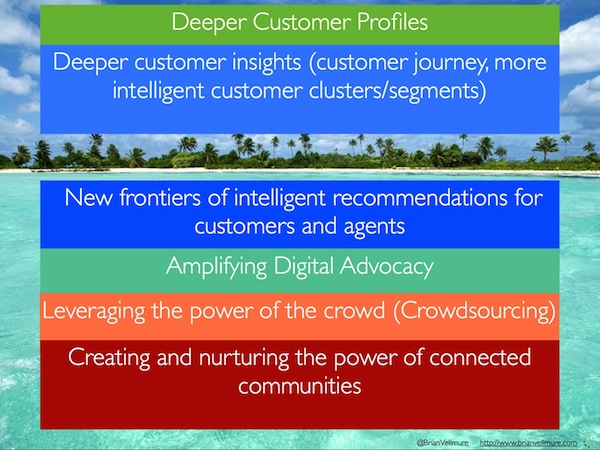I was recently invited to keynote a series of executive events hosted by NICE Systems. For those unaware, NICE serves over 25,000 organizations in the enterprise and security sectors, representing a variety of sizes and industries in more than 150 countries, and including over 80 of the Fortune 100 companies.
At the start of each session, I encouraged contact center and customer experience executives from American Express, Disney, Coca-Cola, Staples, eBay, JP Morgan Chase, Citi, Discover, and several other organizations to commit with me to ask great questions together for the balance of the afternoon.
We are in an era where asking great questions, and collectively pursuing answers together is a necessity. The accelerating pace of technological innovation is disrupting every industry, every best practice, and democratizing opportunity across the globe. The concepts of the learning organization continue to gain traction and has fueled much of the Enterprise 2.0 / Social Business movement over the past decade.
I asked the respective audience(s) in Orlando, Austin, and Salt Lake City to consider the following:
From there, we discussed two major trends:
1. Greater Connectedness
Fundamentally, the reasons that humans connect haven’t changed in millennia. We still share our names, where we’re from, what we do, our interests, preferences, who we know, what we like to do. We form communities of interest, or passion, or purpose. What has changed is that for the first time in the history of the world, billions of people can connect with billions of people.
- Connections between humans are becoming smarter and faster
- Interactions are on a stage for the world to see and respond to
- Digital interactions can now be analyzed for a deeper understanding of the impact of communications between neighbors, brands, enemies, peers, competitors, etc.
According to Peter Diamandis
Right now, a Maasai warrior(a semi-nomadic people from Kenya) on mobile phone has better mobile communications than President Reagan did 25 years ago; And if that same Maasai were on Google, he would have access to more information than President Clinton did just 15 years ago.
.
2. The Digitization of Everything
More and more of our world is being absorbed into a digital format. What we do, where we go, what we learn, what we buy is moving rapidly into the digital realm. From the annihilation of music and print media industries to implanted chips in the military, to smart devices and cars, to “humans on a chip”, and tracking entire ecological systems at a micro or nano level.
What is the impact? Chris Anderson once said, “Every industry that becomes digital eventually becomes FREE”.
If every industry is indeed moving into the digital realm, is every industry indeed moving towards free? Perhaps the better question is “Are your products and services being rapidly commoditized?”
This week I just read how a company is India is working towards distributing a fully functioning tablet computer for $20.
Where Customer Experience Fits
The imaginary world discussed at the beginning of the presentation is the real world of the near future.
In an era where anyone has access to nearly everyone or anything from anywhere, how will you compete? How will you differentiate? How will you create value?
If this line of thinking isn’t on your radar, it should be. It’s critical.
In an era of rapid commoditization, the customer experience is one of the most difficult things to duplicate. Your customers really only want two things from you:
1. Help them accomplish what they’re trying to do, and/or
2. Help them to “feel good”
(I guess I could add a few more through a slightly different lens, like the “Six Things Customers Want”)
These both require an increasingly intimate knowledge of who your customers are, and what they’re trying to accomplish. While traditional products and services are indeed being commoditized, the ability to harness, capture, and utilize unprecedented access to information gives those who are able to identify customer behaviors, needs, preferences, jobs, decision drivers, creatively problem solve, and harness capabilities to create products and services that are simple to understand and consume will win.
Some of the emerging frontiers and opportunities are in the slide below.
In Summary
The two major trends highlighted above are converging to put pressure on nearly every institution, especially for-profit corporations. Customer experience is continuing to move towards the forefront of differentiation capabilities in an increasingly connected, fast paced, digital world. Ironically, the distribution of channels and interactions is simultaneously adding significant complexity to defining and understanding customer journeys, and the impact of a myriad of interactions across that journey.
I’ve included a copy of the entire deck below. I look forward to your thoughts and comments.





